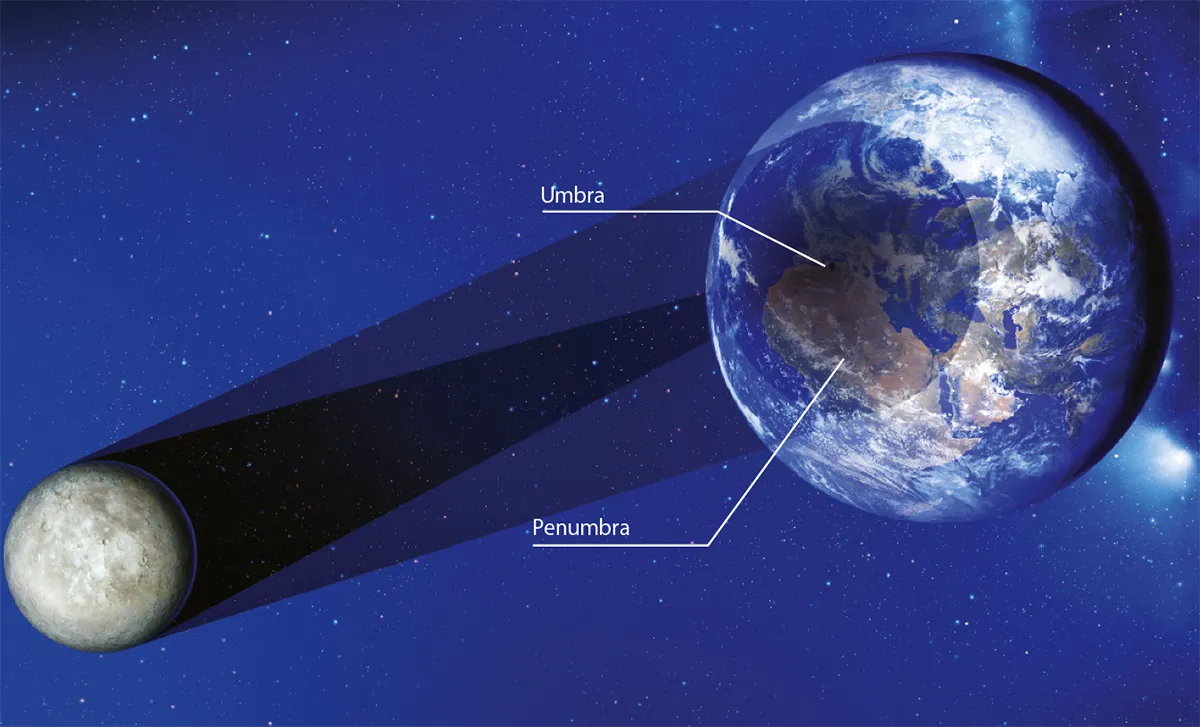There's total lunar eclipse occurring this morning, in the early hours of Tuesday 8 November 2022, and it will be visible in the USA, Canada, South America, Australia and much of Asia.
Given the date on which the November lunar eclipse lands, many in the US are dubbing it the 'Election Day Eclipse'.
In this guide we'll look at how to see the 8 November lunar eclipse, and what you'll observe on the surface of the Moon as you do so.
Find out when the next eclipse is occurring or sign up to receive the BBC Sky at Night Magazine e-newsletter for weekly astronomy and observing advice.

The bad news for those in the UK, Ireland and mainland Europe is that the 8 November total lunar eclipse will not be visible from there.
Some of the eclipse will be visible, however, from northern Scandinavia and parts of eastern Europe.
If you're not going to be in the path of totality during the eclipse, or if you're clouded out on the day, you can watch the eclipse live via the stream below, courtesy of Time and Date:
Unlike a solar eclipse, there is no danger associated with viewing a total lunar eclipse and so the event can be safely seen with the naked eye.
There's no need to use binoculars or a telescope to observe the lunar eclipse, but it won't cause any harm to do so and may even enhance your observing experience.
And it is also possible to photograph a lunar eclipse with a DSLR camera or a smartphone.
The above video is a NASA animated map showing the regions from where the 8 November 2022 lunar eclipse is visible.
Contours mark the edge of the visibility region at eclipse contact times.
Credit: NASA's Scientific Visualization Studio
What is a total lunar eclipse and when do they happen?

A total lunar eclipse occurs when the Sun, Earth and the Moon line up, with Earth in the middle.
During a lunar eclipse, the full Moon moves into Earth's shadow and its surface appears slightly dimmer as a result.
However, sunlight passing through Earth's atmosphere makes the Moon remain visible.
The result is a Moon that often appears red or dark grey to the eye (more on this below).
Lunar totality typically takes over an hour to complete, making it a much slower affair than a solar eclipse.
A lunar eclipse lasts even longer if you take into account the weak penumbral phase of the eclipse, which is when the Moon passes through the lighter outer part of Earth’s shadow.
However, this phase is barely noticeable to the naked eye and probably best captured with a camera.

You may be thinking that this Sun-Earth-Moon alignment must surely happen all the time. Why, then, are lunar eclipses not more regular an occurrence?
The reason lunar eclipses don't happen more regularly is because the Moon’s 5˚ orbital tilt normally has it passing above or below Earth’s shadow in space.
It’s only when there’s a straight-line alignment between the Sun, Earth and Moon that the Moon crosses into Earth’s shadow.
When this happens, the observers on Earth’s hemisphere facing the Moon witness a lunar eclipse.
Understanding the penumbra and umbra

At the Moon’s distance, Earth’s shadow has two parts: a weak outer penumbra and a dark umbra.
The penumbral shadow is the region where, if you were on the Moon looking back towards the Sun, you would see it partially eclipsed by Earth.
At the outer edge of this shadow the partial solar eclipse would be tiny, increasing in magnitude the deeper into the penumbra you go.
The umbral shadow sits at the centre of the penumbra and is the part of Earth’s shadow where all of the Sun’s light would be blocked from view.
The darkness of the penumbra increases towards the umbra.
Why is a lunar eclipse red?

Earth casts an interesting shadow because it has an atmosphere.
Light skimming the edge of our planet is refracted to partly infill the umbra.
As our atmosphere scatters blue light, light that has passed through it tends towards the redder end of the spectrum, giving the umbra a red or orange colour.
How to see the 8 November 2022 lunar eclipse

The penumbral phase of the eclipse,when the Moon passes through the lighter outer part of Earth’s shadow, begins at 08:02 UTC (03:02 EDT).
The effect of this stage of the eclipse is quite subtle, and certainly difficult to see with the naked eye.
At 09:09 UTC (04:09 EDT), first umbral contact occurs and the partial stage of the eclipse begins.
It will look like a bite is being taken out of the Moon.
In the run-up to this stage, part of the Moon’s disc will begin to appear darker than usual.
This is because the edge of the umbra (the inner section of total darkness) is blurred rather than sharp, creating a fuzzy shaded edge as the eclipse begins to take shape.
You can see an animation showing the stages of the 8 November total lunar eclipse via this NASA video:
Totality begins at 10:17 UTC (05:17 EDT), and this is the moment we've all been waiting for, when the Moon is within Earth's umbra and it turns rusty red.
This is the point at which binoculars or a telescope will really help appreciate the mesmerising effects of the total lunar eclipse.
Totality will end at 11:42 UTC (06:42 EDT), and the red tint to the Moon will begin to fade.
By 12:49 UTC the partial eclipse will have ended, and by 13:50 UTC, the lunar eclipse will be over.
For those observing in the EDT time zone, the Moon will have set below the horizon for these last two stages.
For more info, there's a fantastic NASA page on the 8 November total lunar eclipse that's well worth checking out.

